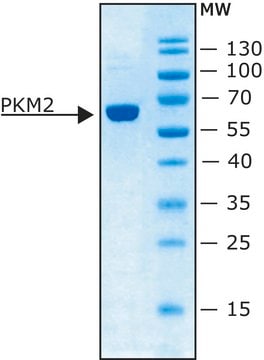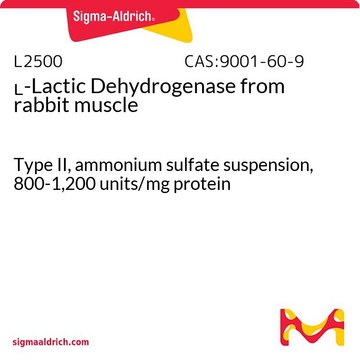P7768
Pyruvate Kinase from rabbit muscle
Type VII, buffered aqueous glycerol solution, 350-600 units/mg protein
Sinónimos:
ATP:pyruvate 2-O-phosphotransferase, PK
About This Item
Productos recomendados
type
Type VII
form
buffered aqueous glycerol solution
specific activity
350-600 units/mg protein
mol wt
237 kDa
concentration
2.0-20.0 mg/mL
foreign activity
lactic dehydrogenase and creatine phosphokinase ≤0.01%
phosphoglucomutase and myokinase ≤0.05%
storage temp.
2-8°C
¿Está buscando productos similares? Visita Guía de comparación de productos
General description
Pyruvate kinase plays a role in regulating cell metabolism. There are four pyruvate kinase isoforms in mammals (PKM1, PKM2, PKR, PKL). Mammalian pyruvate kinase is a tetrameric protein composed of identical subunits, arranged in a dimer-of-dimers configuration. Each monomer contains one active site and consists of three main domains- designated A, B, and C-along with a small N-terminal domain. The M2 isoform of pyruvate kinase (PKM2) supports anabolic metabolism and is expressed in cancer and normal tissue.
Application
Biochem/physiol Actions
Isoelectric Point: 7.6
Optimal pH: ∼7.5
Optimal Temperature: 25°C
ΕA280 = 0.54 for 1 mg(p)/ml, 1 cm path
Reported KM values are ATP (0.86 mM), pyruvate (10 mM), ADP (0.3 mM), and PEP (0.07 mM) in Tris buffer at pH 7.4 and 30 °C. Pyruvate kinase is highly specific for phosphoenolpyruvate, but can utilize other dinucleotide triphosphates as substrates in place of ATP including GTP, ITP, dATP, UTP, and CTP.
Isoelectric Point: 7.6
Optimal pH: ∼7.5
Unit Definition
Physical form
Analysis Note
Storage Class
10 - Combustible liquids
wgk_germany
WGK 2
flash_point_f
Not applicable
flash_point_c
Not applicable
ppe
Eyeshields, Gloves, multi-purpose combination respirator cartridge (US)
Elija entre una de las versiones más recientes:
¿Ya tiene este producto?
Encuentre la documentación para los productos que ha comprado recientemente en la Biblioteca de documentos.
Los clientes también vieron
Nuestro equipo de científicos tiene experiencia en todas las áreas de investigación: Ciencias de la vida, Ciencia de los materiales, Síntesis química, Cromatografía, Analítica y muchas otras.
Póngase en contacto con el Servicio técnico











